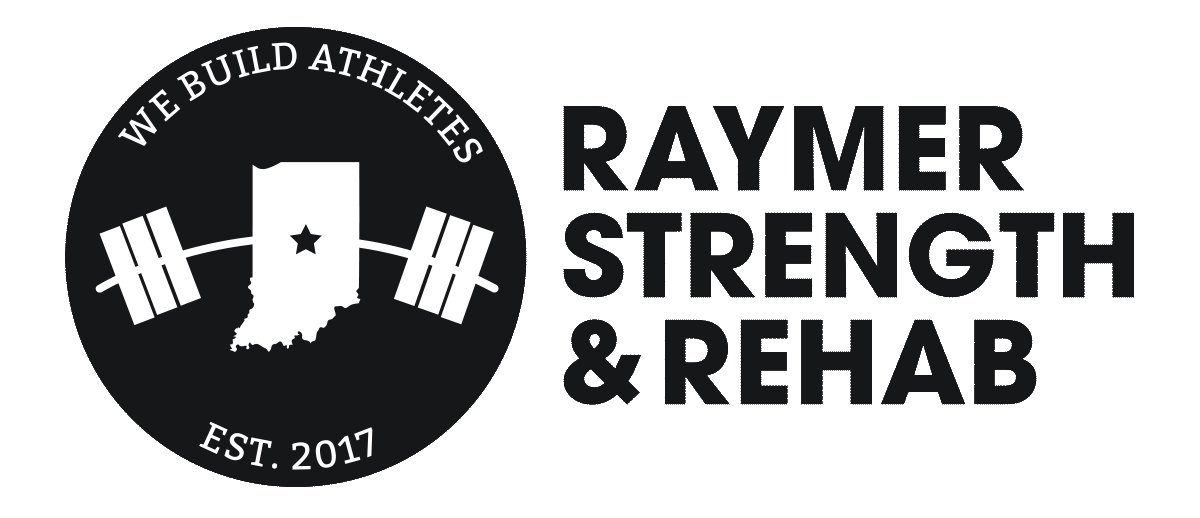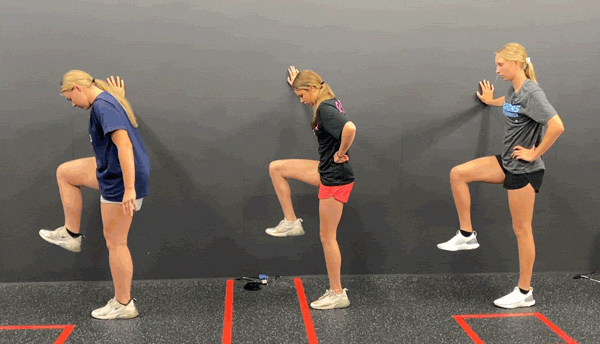Why Softball Pitchers Should Sprint
Photo: Julie L Brown Photography
Recently, I received an excited text from one of our freshman collegiate pitchers who had just started training with her new team on campus. She notched the fastest home-to-first time among the pitchers, and she knows exactly why this is awesome.
Why? Sprint time ratios can potentially correlate to higher pitch velocity (1). And she knows that by combining her strength work with her speed work, she stood the best chance at improving performance in the circle.
So while some softball pitchers might not have to book it to first base with a designated hitter in the lineup, they should still work to improve their speed.
In this article, we’ll be focusing on the impact on lower body mechanics.
Let’s break it down.
Lower body similarities in pitching mechanics and sprinting
One piece of successful pitching means generating ground reaction force through the drive leg over a short period of time (2). The leg drive phase of a pitch is an explosive movement that utilizes linear extension in the ankle, knee, and hip to produce force into the ground in order to accelerate and reach top speed that carries through to the ball’s release.
Get this– sprinting does the same thing… minus the whole throwing the ball part 😉
Left: Alayna Tesnar pitches during a high school game | Right: Alayna Tesnar sprints (follow Alayna on Twitter)
Photo (left): Julie L Brown Photography
There are many ways to train the body to express power via extension, and sprinting is one of those tools. However, it’s more effective than other weight room activities at training ankle stiffness as the feet contact the ground, and it’s crazy effective at developing the muscles in the posterior chain. It also doesn’t require special equipment, and it’s easy to measure.
We recommend that athletes work with a qualified coach (hey, that’s us 👋) to develop efficient sprint mechanics so bad habits don’t impact performance in the circle.
Learn more about how we coach mechanics in Speed Kills: The First Step to Getting Faster.
How speed training contributes to building power
In my recent article, Power Up ⚡: A Parent’s Guide to Training Power, we reviewed the components of the power equation, and how training power translates across age groups as kids grow up. A quick review:
Power = Force x Velocity
Where force is expressed as strength applied against a surface or plane and velocity is expressed as directional speed
Athletes can improve their power by building a bigger capacity through strength training and then teaching that capacity how to move fast through speed training (like sprinting).
For more power in the circle, pitchers must pair strength training with speed training in all planes of motion to see the best performance benefits.
A few ways other movements in the weight room translate to more power in the circle demonstrated by Lily Cash.
Sprint training can reduce chances of injury
A proper sprint training program can be effective at reducing the chances of hamstring muscle injuries (3). The key is to progressively overload athletes so that they adapt to the training demand. Avoid drastic increases in sprint volume as this what could lead to injury. And developing speed means proper rest intervals.
Injury reduction is the #1 priority for strength and conditioning coaches. While this article focuses on the benefits of speed training and sprinting for pitchers, deceleration training is a piece of that. And it should emphasized with pitchers because they expose their landing leg to more force than their drive leg, repeatedly (4).
This is why sports performance training should be left in the hands of qualified coaches to get the best out of increased performance, and to better protect the athletes.
Athletes from the Indiana Bombers work on sprint mechanics
What measurables correlate with pitch velocity?
First of all, correlation is not causation, and lower body kinetics are just one piece of the pitching puzzle. A pitcher doesn’t have a great velocity because they have a great sprint or vertical jump. Rather, correlation is just an indicator that the talent and potential is there. In plain English, you could have the fastest sports car with the biggest motor, but unless you have the skills to race, your results won’t be good.
Pitching velocity is influenced by many factors– skill, height, genetics, recovery rate, and more. But are there ways we can indicate potential? We have to turn to baseball pitching, which has been more well-funded with kinesiology-related studies than softball pitching.
Results are conflicting. A very recent one published in March 2022 found that the sprint ratio between a 10m and 30m dash correlated to positive variances pitch velocity (1), while previous studies had not found a strong correlation in sprint times with velocity (5).
Most studies concur that variations of jump measurements more strongly correlate to baseball pitching velocity. Driveline Baseball does a great job breaking down the pre-2022 data on this topic.
Where does that leave softball and the windmill pitch?
Honestly, we need more data. My hypothesis– the differences in leg drive/lower body mechanics in the windmill pitch versus the baseball pitch may mean that sprint values have a higher correlation to pitch velocity.
How does this influence our training methodology? We will continue to train strength and speed in all planes order to produce power that expresses itself in multiple ways on the playing field.
And more importantly, we will continue to prioritize data collection on pitch load and recovery in order better understand how we can reduce the chances of overuse injuries.
Conclusion
Softball pitchers should not neglect speed training even if they aren’t making plate appearances.
Sprint times and jumps may be indicators of velocity potential, but until more studies are done on the windmill pitch, following a comprehensive speed and strength training program that utilizes all planes of motion remains the most effective way to build power and increase performance in the circle.
And one of the best ways to train speed is to sprint!
Interested in training with us? We work with pitchers in person and online.
References
Huang JH, Chen SH, Chiu CH. Correlation of pitching velocity with anthropometric measurements for adult male baseball pitchers in tryout settings. PLoS One. 2022 Mar 17;17(3):e0265525. doi: 10.1371/journal.pone.0265525. PMID: 35298532; PMCID: PMC8929570. (https://www.ncbi.nlm.nih.gov/pmc/articles/PMC8929570/)
Pletcher ER, Friesen KB, Oliver GD, Lovalekar M, Gorse K, Nagai T, Connaboy C. Drive leg ground reaction forces and rate of force development over consecutive windmill softball pitches. J Sports Med Phys Fitness. 2022 Jul;62(7):898-903. doi: 10.23736/S0022-4707.21.12644-1. Epub 2021 Jun 28. PMID: 34180650.
Pascal E, Jurdan M, Kenny G, Johan L, Pierre S , and Jean-Benoˆıt M. Sprinting: a potential vaccine for hamstring injury? Sports Performance and Science Reports. 2019 Jan. https://sportperfsci.com/wp-content/uploads/2019/01/SPSR55_Edouard_190108_final.pdf
Werner SL, Guido JA, McNeice RP, Richardson JL, Delude NA, Stewart GW. Biomechanics of youth windmill softball pitching. Am J Sports Med. 2005 Apr;33(4):552-60. doi: 10.1177/0363546504269253. Epub 2005 Feb 8. PMID: 15722291.
Lehman G, Drinkwater EJ, Behm DG. Correlation of throwing velocity to the results of lower-body field tests in male college baseball players. J Strength Cond Res. 2013 Apr;27(4):902-8. doi: 10.1519/JSC.0b013e3182606c79. PMID: 22706576.




